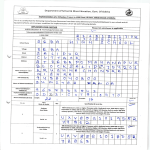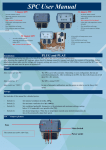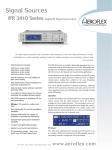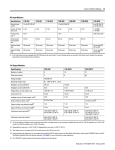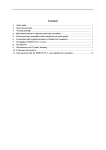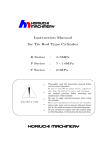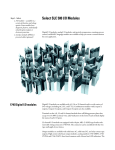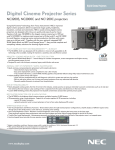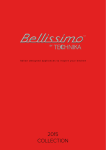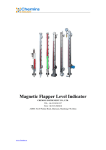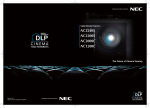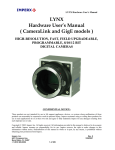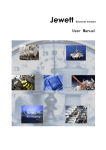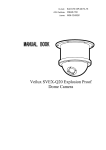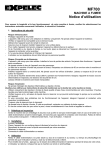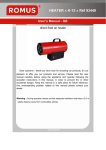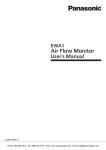Download Brief User Manual-turbine flowmeter for liquid_1_
Transcript
RLT Instrumentation (Unit of RLT Group) TECHNICAL INFO Turbine Flow Meter Techbine - RTB series 1. Summary. 2. The basic parameters and technical performance (1) basic parameters: see table 1 Table 1 LWGY□ Type □□□ □ □ □ Description RTBY Basic type, +5-24 DVC power supply, RTBA 4 ~ 20mA two-wire current output RTBB Battery-powered local LCD indicator Local LCD indicator/4~20mA two-wire current output RTBC DN(mm) 4 4mm, 0.04 ~ 0.25m3 / h 6 6mm, 0.1 ~ 0.6m3 / h 10 10mm, 0.2 ~ 1.2m3 / h 15 15mm, 0.6~6m3 / h 20 20mm, 0.8~8m3 / h 25 25mm, 1 ~ 10m3 / h 32 32mm, 1.6 ~ 16m3 / h 40 40mm, 2 ~ 20m3 / h 50 50mm, 4 ~ 40m3 / h 65 65mm, 8 ~ 80m3 / h 80 80mm, 10 ~ 100m3 / h 100 100mm, 20 ~ 200m3 / h 125 125mm, 25 ~ 250m3 / h 150 150mm, 30 ~ 300m3 / h 200 200mm, 80 ~ 800m3 / h non-explosion-proof type Explosion Explosion-proof type B Precision grade B 1% accuracy For DN4-DN40, process connection is thread type, Max pressure is 6.3Mpa. For DN50-DN200, process connection is flange type. Max.pressure is 2.5Mpa; For DN4-DN10, sensor was equipped with straight pipe and filter. For sensor over DN15, straight pipe can be equipped per request. ℃ People are our prime mover RLT Instrumentation (Unit of RLT Group) 1. T he ambient temperature: -20 ~ +55 ℃ 2. Power supply: Voltage: +5-24 VDC, Current: ≤ 10mA 3. Transmitting distance from sensor to display instrument up to 1000m. 4. Medium temperature: -20 ~ +120 3. Installation, use and adjustment (1) Installation The installation type of sensors can be thread or flange based on sensor size. Please view Figure 1, Figure 2, Figure 3, for installation. See table 2 for installation size. 1.Filter 2.Prior straight pipe 3. turbine 4.Pre-amplifier 5.body 6.rear straight pipe Overall structure × Filter × RTBY -4~10 Sensors structure and Installation 1.pressing part, 2.Bolt 4 14, 3.washer, 4.Sealing gasket, 5.steel wire 1Cr18Ni9Ti-0.8 2.5, 6.Filter, 7.holder People are our prime mover RLT Instrumentation (Unit of RLT Group) 1.body, 2.prior flow-guider, 3.turbine, 4.rear flow-guider, 5. amplifier Figure 2 RTBY -15 ~ 40 sensors structure and installation Figure 3 RTBY-50~200 Sensors Structure and Installation 1.Ball bearings, 2.prior flow-guider, 3.pressing part, 4.body, 5.amplifier, 6.turbine, 7. Bearings, 8. shaft People are our prime mover RLT Instrumentation (Unit of RLT Group) Figure 4 wiring between sensors and indicator Table 2 D(mm) d(mm) 287 Φ125 Φ160 Φ18 Φ18 4 8 322 367 Φ180 Φ250 Φ18 Φ25 8 8 DN(mm) L(mm) H(mm) G L'(mm) 4 6 275 275 145 G1/2 215 145 G1/2 215 455 75 165 173 G1/2 G1 350 RTBY-15 10 15 RTBY-25 25 100 180 G5/4 RTBY-40 40 50 140 150 178 252 G2 80 200 100 150 220 300 RTBY -4 RTBY-6 RTBY-10 RTBY-50 RTBY-80 RTBY-100 RTBY-150 Holes ◆Sensors can be installed horizontally or vertically. If the sensor was installed vertically, liquid shall flow upward. Pipe shall be filled fully with liquid and without bulb. The direction of liquid flow shall follow the arrow marked on the sensors. There shall be at least 20D straight pipe prior to the sensor and 5D straight pipe behind the sensors. The wall inside should be smooth and clean. There shall be no dents, fouling and furrow on wall inside. The axis of sensor should be aligned with the axis of adjacent pipeline. Sealing gaskets shall not rise over wall inside. ◆Sensor should stay away from outside world electric and magnetic fields. If necessary, please People are our prime mover RLT Instrumentation (Unit of RLT Group) take effective screening measures in order to avoid external interference. ◆If sensors were installed outdoor, please take water-proof measure to protect the amplifier. ◆By-pass pie was suggested to install so that liquid transference does not have to be stopped during overhaul. ◆If the fluid contains impurities, filter shall be installed. Filter mesh is up to the size of impurity. Generally mesh number 20-60 was suggested. When there's bulb in the fluid, air-eliminator should be installed. The entire pipeline system should be sealed will. ◆Users should fully aware of the corrosions of medium to protect sensor against corrosion. (2) Operation and adjustment ◆To keep liquid clean and no fiber and impurity. ◆Please open valve slowly and fill the sensor gradually. High water hamper to the empty sensor was prohibited. ◆Normally sensor maintenance period is six months. During cleaning of sensor, please pay attention not to damage measurement cavity parts, especially the turbine. Before assembly, please pay attention to the relationship between the turbine and flow-guider. ◆For storage, please clean the liquid inside the sensor, and cover 2 ends of the sensor against impurity entering the sensor. Please keep the sensor in dry and clean place ◆For equipped filter, please clean it periodically. When it's not used, please clean and store it just as to sensor. ◆Sensor's transmission cable can be laid overhead or underground (please put the cable into metal pipe if it's buried underground.) ◆Before sensors installed, please connect electrically the sensor to indicator to see whether indicator shows flow when user rotates the turbine. If no flow displays on indicator, please check the relevant part to kill trouble before installation. People are our prime mover RLT Instrumentation (Unit of RLT Group) 4. Maintenance and common fault Sensors may have a general fault. Please shoot the trouble against table 3. Maintenance cycle should not exceed six months. Table 3 No. Fault Display 1 Reasons phenomenon instrument shows on flow 1. Connected to power, according 1. No powered or wrong voltage. to requirements of a given 2. Fault with display instrument voltage. 2. Check display instrument. 1. Sensor and display instrument was connected wrongly (open-circuit, short 2 Elimination Display circuit, poor contact, such as fault) instrument works 2. Fault with amplifier well but shows no 3. Converters (coil) open or short flow. circuit. 4. Turbine was stuck or no liquid flows in pipe. 1. Check wiring according to Figure 2. Repair or replace amplifier. 3. Repairing or replacing the coil. 4. Cleaning sensor and pipe. Opening valves or pumps to clean pipelines. 1. The actual flow exceeds sensor flow-range or not stable. 2. Instrument coefficient K setting is incorrect. 3. Sensor turbine was wrapped with 3 Display impurities like fiber. instrument does 4. There's bulb in the liquid. work steadily or 5. Sensor next to strong measurement is electromagnetic field interference. not correct. 6. Sensor bearings and shaft were seriously worn. 7. Sensor shielded cable or other grounding wires and lines disconnected or bad grounded. 8. Display Instrument fault. 1. the measured flow-range shall be suitable to the sensor flow-range, to keep flow steady. 2. To correct coefficient K. 3. Cleaning sensor. 4. Take measures to eliminate air bubbles. 5. As far as possible away from sources of interference or shielding measures. 6. Replace flow-guider or turbine shaft 7. Wire according to Figure 4 8. Repair display instrument. 5. Transportation、storage Transportation and storage in accordance with the following conditions: a, Rainproof dampproof place and package b, No mechanical vibrations or shocks c, Temperature range -20 ℃ ~ +55 ℃ d, Relative humidity of not more than 80% e, The environment is non-corrosive gases. People are our prime mover






